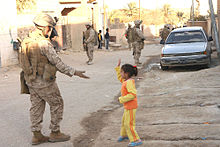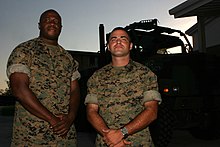3rd Battalion, 23rd Marines
| 3rd Battalion, 23rd Marine Regiment | |
|---|---|
Saint Louis, Missouri | |
| Motto(s) | "Non Sibi, Sed Patria" |
| Engagements | World War II
Operation Desert Storm
|
| Commanders | |
| Current commander | Lieutenant Colonel Cameron D. McCoy |
| Notable commanders | John R. Lanigan |
3rd Battalion, 23rd Marine Regiment (3/23) is a
Current units
| Name | Location |
|---|---|
| Headquarters and Service Company | Bridgeton, Missouri |
| TOW Section | Broken Arrow, Oklahoma |
| India Company | North Little Rock, Arkansas |
| Kilo Company | Smyrna, Tennessee |
| Lima Company | Montgomery, Alabama |
| Weapons Company | Springfield, Missouri |
Mission



The unit's mission is to provide a well-trained and credible force, capable of rapidly mobilizing to augment or reinforce active duty Marine Corps forces participating in missions ranging from humanitarian/peacekeeping operations to major conflicts, in time of war, national emergency or contingency operations and during peacetime to provide operation tempo relief for active forces throughout the spectrum of operations including Joint and Combined Operations. Infantry battalions are the heart and soul of the
Organization
A Marine infantry battalion is organized into three rifle
History
World War II
3rd Battalion, 23rd Marines was activated on 22 July 1942, at what is now

This war-time shuffling provided the major building blocks for 4th Marine Division. The units were originally separated, however, with the 24th Marines and a variety of reinforcing units (engineer, artillery, medical, motor transport, special weapons, tanks, etc.) at
After intensive training, 23rd Marines shipped out on 13 January 1944, and in 13 months made four major
, with the division suffering more than 17,000 casualties.Roi-Namur
An account [citation needed] of 23rd Marines attack during the battle of Roi-Namur: "As dawn broke on D plus 1 (February 1, 1944), the LVT's waddled out of the jaws of the LST's and took up their circling, while the air strikes and naval bombardment mounted in fury. Originally, 1000 had been designated as H-hour, but, due to unforeseen difficulties (such as the lack of usable LVT's), it was changed to 1100. As It was, the first waves did not land till nearly 1200. RCT 23 attacked Roi with its strategic airfield. After the earth-shaking barrage of naval shells and aerial bombs, climaxed by a deluge of rockets fired from LCI's, opposition on Roi was comparatively light, and the 0-1 line was reached at 1217. After pulling back some over-extended units and reorganizing, RCT 23 continued the attack about 1530. The twisted steel skeletons of the hangars and the shattered remnants of the Jap planes were overrun, and the northern edge of the island was reached by 1800. All that remained was mopping up the enemy snipers who were still hiding in the drainage ditches. This was completed by the next morning, February 2, and at 0800 Roi was declared secure. The third battalions Shore Party was the Seabees of 3/20."
Saipan
For Saipan the 23rd landed on beaches blue 1 & 2. Shore party for 3/23 was the third battalion
Iwo Jima
For Iwo 3/23 was commanded by Col. Shelton Scales
23rd Marine Regiment was awarded two
Operation Desert Shield/Desert Storm
3rd Battalion, 23rd Marines was activated in Nov 1990 and deployed to
Detailed synopsis of 3/23 Desert Storm Assault
3d Battalion, 23d Marines was assigned the G-Day missions of (1) providing security in the division zone forward of the Saudi defensive berm, which was located on the Saudi-Kuwait border, prior to G-Day; (2) passing through the breach lanes, and: (3) clearing its zone of action to support the attack north, and (4) screening to the northeast in order to allow 3d Battalion, 10th Marines (3/10) to establish artillery firing positions to provide preparation fires for offensive operations. Phase One was the conduct of the route reconnaissance by TOWs, heavy machine guns (HMG), combat engineers, snipers, and artillery reconnaissance assets. Phase Two was the introduction of one motorized infantry company, the battalion command element, and the 81 mm mortar platoon in the forward sector. The motorized company would be placed in a blocking position oriented northwest, facing possible Iraqi units being flushed out by 2nd LAR screening to the northwest. The teams were tasked to position themselves between the Iraqi defenses and friendly artillery to screen the Iraqi forward defensive belt, and orient to the northeast. Phase Three would be the movement of the artillery units to their firing positions on 23 February 1991, G-1, under the cover of darkness.[6]
On 22 February 1991 (G-Day minus two), 3/23 commenced combat operations as bulldozers cut three gaps in the Saudi berm to allow 3/23 and 3/10 to execute their missions. Approximately halfway through Phase One, the 8th Marines further tasked 3/23 to provide a Forward Air Controller close to the Iraqi defenses to control an air strike on a pumping station in the Umm Gudair oil field, which had been determined to be a high priority target. This required the 81 mm mortar element to move forward of their assigned position in order to range the target for back-up marking capability. A number of Iraqi infantry and trucks were observed in and around the Iraqi trench line. In the waning daylight of 22 February 1991, the Iraqis were engaged by the forward 3/23 81 mm mortars. Simultaneously, the 3/23
At 0615 on 25 February 1991, G+1, 3/23 passed through the breach with 8th Marines, with the bulk of the battalion mounted on M923 5-ton trucks. During the execution of this part of the operation, Company H capture 20 POWs, sustaining no friendly casualties. 3/23 was directed to continue the movement to contact north with 8th Marines as the motorized battalion reserve. The 8th Marine Regimental Commander's intent was to utilize 3/23 for an envelopment, blocking force, MOUT operations, MSE security, flank screen/security, or POW security. As the tactical situation developed during the movement to contact on G+1, it became evident that
At 2330 on 26 February 1991, 3/23 was subsequently directed to continue clearing the farm complex from which fire had been received the previous day. The number of Iraqi troops in the area was still undetermined due to the large number of bunkers and buildings in the complex. 8th Marine Regimental headquarters dispatched tanks from Company C,

After September 11
Operation Enduring Freedom and Operation Iraqi Freedom 2003-2008


3/23 was mobilized on 5 March 2003, and deployed to Iraq with the
3/23 was mobilized for

Africa in 2009
3/23 deployed to
Hurricane Katrina

The headquarters for 3rd Battalion, 23rd Marine Regiment, was caught in the middle of Hurricane Katrina in late 2005. The majority of the battalions members were authorized to provide security for their families and leave the immediate area. A contingent of Marines from 3/23 volunteered to stay behind and assist the local community, as well as act as a liaison for the 24th Marine Expeditionary Unit, who was deployed to the region to assist with disaster relief.
Notable former members
- Private First Class Clinton M. Adcock, Navy Cross[11]
- Private First Class Josiah Scott Bell, Navy Cross[12]
- Private First Class Douglas T. Jacobson, Medal of Honor[13]
- Howard Johnson, killed in action during the Battle of Iwo Jima
- Jamey Johnson
- Frank Gambino, Navy Cross[14]
- Gunnery Sergeant Addies S. McGinn, Jr., Navy Cross[15]
- John H. Yancey, circa 1946-1950
- Corporal Cook, Steven E., Navy Achievement Medal
Awards
- Presidential Unit Citation (World War II)(I MEF Iraq 2003)[citation needed]
 Navy Unit Commendation with three Bronze Stars (World War II, Desert Storm, II MEF Iraq 2007)
Navy Unit Commendation with three Bronze Stars (World War II, Desert Storm, II MEF Iraq 2007)- National Defense Medalwith two Bronze Stars (World War II, Desert Storm, War on Terror)
- Asiatic-Pacific Campaign Medalwith 4 Arrowheads (World War II)
 World War II Victory Medal
World War II Victory Medal- Navy Meritorious Unit Commendation[16]1990-91
 Southwest Asia Service Medal with two Bronze Stars (Desert Shield, Desert Storm)
Southwest Asia Service Medal with two Bronze Stars (Desert Shield, Desert Storm) Global War on Terrorism Expeditionary Medal (Iraq 2003)
Global War on Terrorism Expeditionary Medal (Iraq 2003) Global War on Terrorism Service Medal
Global War on Terrorism Service Medal Iraq Campaign Medal with three Bronze Stars (2003-2008)
Iraq Campaign Medal with three Bronze Stars (2003-2008) Kuwait Liberation (Saudi Arabia)
Kuwait Liberation (Saudi Arabia) Kuwait Liberation (Kuwait)
Kuwait Liberation (Kuwait)- Combat Action Ribbon (Desert Storm)
- Navy Sea Service Deployment Ribbon (Desert Storm, Afghanistan)
- Afghanistan Campaign Medal with one Bronze Star (2018)
- Joint Meritorious Unit Citation (Afghanistan)
See also
- List of United States Marine Corps battalions
- Organization of the United States Marine Corps
- 23rd Marine Regiment (United States)
- Headquarters Company 23d Marines (HQ/23) - San Bruno, California
- Ellington Field, Texas
- 2nd Battalion, 23rd Marines (2/23) - Pasadena, California
- Chicago, Illinois
- Truck Company 23rd Marines - Nellis Air Force Base, Nevada
- Combat Logistics Battalion 23 formerly 4th Landing Support Battalion (aka the 4th Pioneers)
- Naval Mobile Construction Battalion 133
- Seabees
Notes
- ^ a b List of United States Marine Corps battalions
- ^ John C. Chapin, "The 4th Marine Division in World War II", "U.S. Marine Corps", 1976
- ^ Rottmann, Gordon L. (2002). US Marine Corps World War II order of battle : ground and air units in the Pacific War, 1939-1945. Westport, Connecticut: Greenwood Press. pp. 218–220.
- ^ [1]|"Col Shelton Scales and the 133rd NCB" interviewed by Lt. Col Oliver North
- ^ How Annex 4th Marine Division Operations Report, April 1945, National Archives, College Park, MD,20704
- ^ a b c d "History for 3rd Battalion, 23rd Marines". Military.com. Retrieved 23 February 2014.
- ^ "3/23 Marine Scout Snipers in Iraq". YouTube. Archived from the original on 2 July 2014. Retrieved 23 February 2014.
- ^ "New Orleans Battalion begins return from Iraq". Archived from the original on 1 March 2014. Retrieved 16 July 2012.
- ^ "Photos : News Photo". Defense.gov. 16 June 2009. Retrieved 23 February 2014.
- ^ a b Cullen J. Tiernan, "Exercise African Lion 2011 features extensive upgrades, highlights strength of U.S.-Moroccan relationship", 2011-5-11
- ^ "Clinton Adcock - Recipient -".
- ^ "Josiah Bell - Recipient -".
- ^ "UNTO THE BREACH » Douglas T. Jacobson Medal of Honor citation". Victoryinstitute.net. Retrieved 23 February 2014.
- ^ "Frank Gambino - Recipient -".
- ^ "Addies McGinn - Recipient -".
- ^ "NAVMC 2922 August 2012" (PDF). Archived from the original (PDF) on 30 July 2018. Retrieved 4 June 2017.
References
![]() This article incorporates public domain material from websites or documents of the United States Marine Corps.
This article incorporates public domain material from websites or documents of the United States Marine Corps.
- Web

